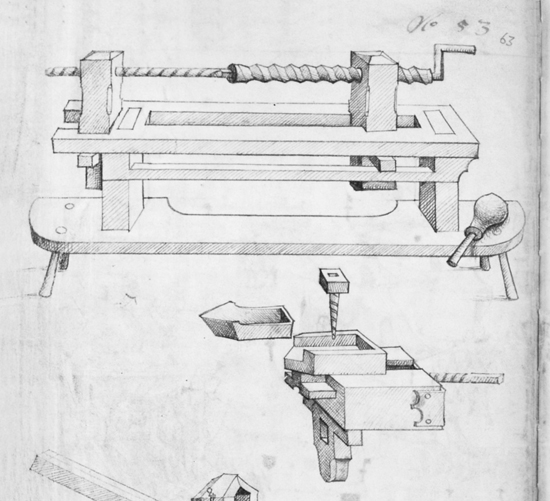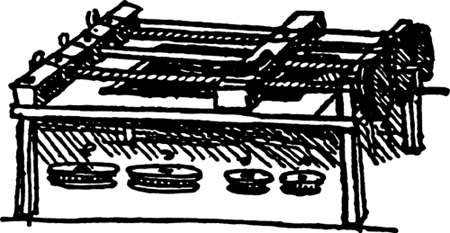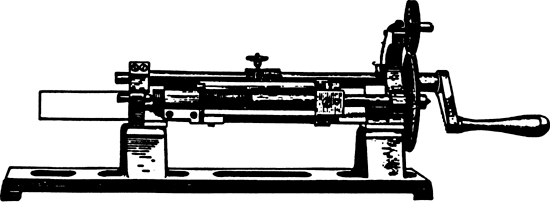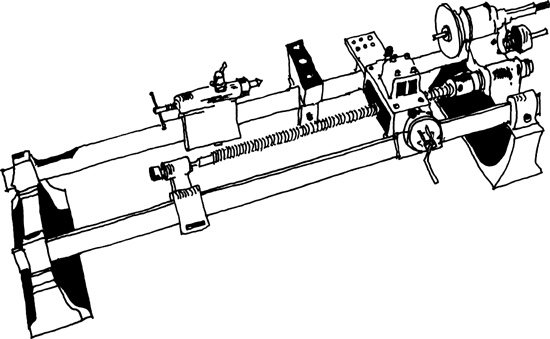
IN READING ABOUT the Wyatt brothers’ factory in Staffordshire, I had been struck by the statement that their screw-making machines were operated by children. During the eighteenth century, children commonly worked in coal mines, workshops, and factories, but were usually given only menial tasks. Even a machine as simple as a screw girder’s spindle required an experienced—not to say strong—operator. The Wyatt machines were obviously different. I had stumbled on a landmark of industrialization.1 At a remarkably early date—the industrial revolution would not get fully under way for another hundred years—the Wyatt brothers not only pioneered the use of multipurpose machines to achieve mass production, they were the first to put into place the guiding principle of industrialization. Their factory was the earliest example of an industrial process designed specifically to shift control over the quality of what was being produced from the skilled artisan to the machine itself.
The screw girder’s spindle and the Wyatt brothers’ screw-making machines are both examples of simple turning-lathes. In a lathe, the blank, or workpiece, is rotated around an axis, somewhat like a potter’s wheel. However, while a potter creates a shape by building up clay, the turner removes material. As the workpiece turns, a sharp cutter is applied to the surface and, depending on the desired shape, removes inequalities until every part is equidistant from the axis. The lathe is an ancient tool that appears to have been invented in Europe, since the earliest surviving pieces of lathe work are an eighth-century B.C. Etruscan bowl, and a sixth-century B.C. bowl found in Upper Bavaria.2 Although these wooden objects were definitely turned, nothing is known of the lathes themselves. Turning technology eventually spread to the rest of the Mediterranean world, including Egypt, where the oldest depiction of a lathe, dating from the third century B.C., has been found in a bas-relief on a grave wall. The piece being turned, which appears to be a furniture leg, is held vertically. The turner’s cutting tool resembles a chisel; his assistant rotates the piece by pulling a cord looped around the rotating axle, or mandrel. Since the workpiece rotates in alternate directions, the turner cuts only on every other turn.
The Egyptian bas-relief shows the turner and his assistant kneeling on the ground. It reminds me of my first visit to India, when I saw a carpenter at work squatting on the floor. Just as the world is divided into those who wrap and those who button up, or those who eat with their fingers and those who eat with utensils, it is divided into craftsmen who work kneeling, squatting, or sitting on the ground, and those who work erect—or sitting—at a bench. The ancient Egyptians belonged to the former category; the Romans, to the latter. Since the Romans invented the plane, they needed a flat surface to which the workpiece could be fastened, and the result was the first carpenter’s bench.
Although Europeans in the Middle Ages often relaxed by sitting on cushions on the floor in the Oriental manner, they worked erect. This habit probably prompted the thirteenth-century European invention of the so-called pole lathe. The turner works standing up at a pole lathe. The workpiece rotates not vertically but horizontally. A cord is looped around the mandrel with one end attached to a hinged treadle, and the other fastened to a flexible pole, resembling a bowed fishing rod, that keeps the cord taut. The turner, alternately pressing and releasing the treadle with his foot, now has both hands free to guide the long-handled cutter, which he braces under his arm or over his shoulder for added stability. Like the Egyptian lathe, the pole lathe turns back and forth.
Screw-cutting lathe, from The Medieval Housebook of Wolfegg Castle, c. 1475–90.
The simple pole lathe was used by wood turners for a long time—working examples survived in England until the early 1900s. For turning metal, however, a more effective machine was required. Here the screw again plays a vital role, for the ancestor of the modern lathe is in fact a machine for cutting screws. It was invented almost three hundred years before the Wyatt brothers’ screw-making lathes and appears in the Medieval Housebook, the fifteenth-century manuscript that I had consulted in the Frick Collection. The beautiful drawing is precise. The lathe, a radical departure from the pole lathe, consists of a heavy frame mounted on a solid workbench. The blank is held horizontally between two adjustable supports and rotated by turning a hand crank. One end of the blank is attached to a lead screw. As the blank turns, the lead screw advances through a threaded hole in one of the supports and pushes the blank through a box containing a sharp cutter that incises the thread. The operator has only to set up the blank in the jig, wedge the threaded support and the cutter-box in place, adjust the depth of the cutter, and turn the crank.
The Housebook lathe is made of wood, but it is a true machine tool; that is, it is a tool in which the machine—not the craftsman—controls the cutter.3 It anticipates many features of the modern bench lathe: the two supports (today called a headstock and a tailstock); the frame (ancestor of the modern slide-rest) that allows flexibility in the location of cutter-box and stocks; a continuous drive that can be connected by a belt drive to an external power source such as a waterwheel; a rotating lead screw that advances the blank by tiny increments; a design that integrates the lathe with the workbench; and heavy construction that assures rigidity and a relatively high degree of precision.
The drawing of the lathe appears on the same manuscript page of the Medieval Housebook as the manacles, wrenching tools, and slotted screws. The slotted screws, which are tapered, were obviously filed by hand; the lathe was used to turn the long wrought-iron screws that are part of the wrenching tools. It is several weeks since I visited the Frick, but I still have an illustrated catalog from the exhibition, and I examine the drawing of the lathe closely, trying to understand how it works.4 The pointed cutter, which must have been tempered steel, is threaded to enable the operator to adjust the depth of the cut. It would have taken many passes to cut a thread into a hard wrought-iron rod. After each pass, the workpiece was retracted, the cutter was tightened to cut a deeper groove, and the operation was repeated. A lengthy process, but one that probably produced a reasonably accurate screw.
The drawing of the lathe includes a short-handled tool lying on the workbench. At first I assume that it is some sort of chisel or gouge. But as the exact functioning of the lathe becomes clearer, it is obvious that a chisel plays no part in the process. The author of the Medieval Housebook is thorough and his drawings do not usually contain extraneous information. While beautifully composed, these are technical documents that carefully describe how the various machines work, and exactly what tools are needed to operate them. A view of a spinning wheel, for example, includes a couple of empty spools. So what is the function of the mysterious tool? One day, while I am puzzling over the drawing again, I realize that the blunt end is exactly the same size as the slot in the head of the cutter. Of course. It’s not a chisel, it’s used to adjust the cutter. It’s a screwdriver.
Eureka! I’ve found it. The first screwdriver. No improvised gadget but a remarkably refined tool, complete with a pear-shaped wooden handle to give a good grip, and what appears to be a metal ferrule where the metal blade meets the handle. Since the Housebook was written during the last quarter of the fifteenth century, there is no doubt that a full-fledged screwdriver existed three hundred years before the tool portrayed in the Encyclopédie. This confirms what I had suspected: the screwdriver and the screw were invented at about the same time. My guess about fifteenth-century armorers and gunsmiths was not far off the mark either. The Housebook lathe is illustrated in a chapter devoted to the technology of war, so it is likely that screwdrivers appeared first in military workshops, though perhaps not in France, as I had assumed, but in Germany.I
—
For some reason, the potential of the Housebook lathe was not immediately recognized. Perhaps the unknown inventor did not publicize his lathe; as far as we know, the Housebook existed in only one copy, and medieval craftsmen were often possessive about their work. Yet it appears that Leonardo da Vinci, at least, was aware of the innovative lathe, for in the early 1500s he designed a number of screw-making machines, one of which bears a striking resemblance to the earlier machine. Characteristically, Leonardo made improvements. Instead of advancing the blank through the cutter, he made the cutter move along the rotating blank, as it does in a modern lathe. Further, by using different interchangeable gears (four are shown in his sketch), he could make the cutter advance at different rates. Since the blank was turning at a constant rate, if the cutter moved more slowly, the pitch (the distance between the threads) of the resulting screw was smaller; if the cutter moved more quickly, the pitch was larger. Thus, the same machine could make screws with four different pitches. As with so many of Leonardo’s inventions, it is unclear if this remarkable machine was actually built.

Leonardo da Vinci’s screw-cutting machine, c. 1500.
Jacques Besson’s screw-cutting machine, 1579.
Although Agostino Ramelli worked in France, Leonardo’s actual successor as engineer to the French court was Jacques Besson, who designed several screw-cutting lathes.5 Besson’s lathes were extremely elaborate, turned not by means of a crank but by pulling on counterweighted cords. This produced the old-fashioned alternating rotation and also resulted in slippage and a loss of power. But efficiency was not uppermost in Besson’s mind, for his machines were not intended for industrial workers but for hobbyists. Turning had become the gentleman’s equivalent of needlepoint and remained in vogue as a pastime until the end of the eighteenth century. “It is an established fact that in present-day Europe this art is the most serious occupation of people of intelligence and merit,” wrote Fr. Charles Plumier, who published the first treatise on the lathe, L’art de tourner, in 1701, “and, between amusements and reasonable pleasures, the one most highly regarded by those who seek in some honest exercise the means of avoiding those faults caused by excessive idleness.”6 Hobbyists turned a variety of materials, not only wood, but also horn, copper, silver, and gold. Although the products of their labors were purely decorative, they took their machines seriously. The lathes could be simple bench models driven by a treadle, or complex machines with cams and other devices for making elaborate forms, including ornamental screws. The so-called guilloching lathe was capable of tracing complex intertwining curves onto flat disks such as watch cases and medallions. Louis XVI owned a guilloching lathe equipped with a mahogany bench, a gilded iron regulating device, and a tool-holding carriage of gilt bronze inset with the royal coat of arms.7
Aristocrats used lathes to fill their idle hours, but for others, precision lathework was a purposeful occupation. In 1762, a London instrument-maker named Jesse Ramsden began a project that would revolutionize the lathe. Ramsden, born in Yorkshire in 1735, had originally been apprenticed to a cloth-maker. When he was twenty-three, he unexpectedly quit his trade and went to London to work for a maker of mathematical instruments. Four years later, he opened his own business. Now, to make his mark, he set out to solve a problem that plagued instrument-making: graduated scales. Linear scales, subdivided into standard measures, were a key ingredient of sextants, theodolites, and instruments used in astronomical observation. Graduated scales were traditionally made by hand and hence lacked accuracy. Ramsden designed a scale-dividing machine that was capable of engraving scales with great precision.
The machine incorporated long, fine-threaded regulating screws of microscopic accuracy. Regulating screws, the refined relatives of ordinary screws, convert rotation into minute horizontal movement by means of tracking pins or nuts. To ensure accuracy, the threads must meet stringent requirements: pitch must be constant; the cores must be exactly parallel and concentric; and the friction against the adjusting nut must be minimal but steady. In other words, these screws must be perfect.
Since screws of such precision were not available, Ramsden set out to make them himself. It was a daunting problem: how to produce a perfect screw using a lathe with an imperfect lead screw. Patiently, he produced a succession of screws of increasingly greater accuracy. In the process, he made important improvements to the lathe. At a time when most instrument-makers still used wooden pole lathes, he built bench lathes entirely of steel. He invented a triangular slide bar, which gave more accuracy, and he was also the first to use diamond-tipped cutting tools. He finally was able to produce a screw with a claimed accuracy of one four-thousandth of an inch. In all, it took him eleven years to build his dividing machine.

Jesse Ramsden’s precision screw-cutting lathe, 1777.
Ramsden’s achievement had enormous implications. Accurate regulating screws were incorporated into a variety of precision instruments and opened up new worlds to science as they facilitated the work not only of astronomers, but also of physicists, who depended on accurate regulating screws in microscopes. Other new worlds were opened up, too. The navigation instrument most affected by Ramsden’s work was the sextant. A sextant incorporates an arclike graduated scale that spans sixty degrees (one-sixth of a circle, whence the Latin root sextus), a movable radial arm, and a fixed telescope. The navigator “shooting the sun” lines up the horizon in the telescope, then adjusts a mirror attached to the radial arm until he sees a reflection of the sun. The angle between the mirror and the telescope, which is read off the graduated scale, corresponds to the angle of the sun above the horizon. With this information, and the aid of published tables, the exact latitude can be computed. Thanks to Ramsden’s scale-dividing machine, it was possible to know a ship’s position to within ten seconds of latitude, or about a thousand feet. Such accuracy facilitated the feats of navigation and great voyages of discovery of explorers like Captain Cook.
—
Ramsden was working on his screw-cutting lathes in London at the same time the Wyatt brothers were organizing their screw factory in Staffordshire. The scientific instrument-maker’s precision machines and the crude factory lathes both used regulating screws, but they existed in two different realms. These realms were soon to meet, thanks to the inventive genius of Henry Maudslay. Maudslay was born in 1771 in humble circumstances and was apprenticed to a blacksmith in the Royal Arsenal at Woolwich, near London. Unusually gifted as a metalworker, Maudslay came to the attention of Joseph Bramah, a prominent manufacturer and inventor. Bramah was looking for someone to make a prototype of his latest invention, an unpickable bank lock. The design, which incorporated numerous tumblers, was so complicated that it had confounded his own experienced craftsmen. Maudslay, then only eighteen, not only successfully built the prototype, but also designed and built the tools and machines needed to commercialize its production.II
The burly young blacksmith was a mechanical prodigy. Just as some people have a natural aptitude for chess or playing the violin, Maudslay could shape metal with a dexterity and precision that amazed his contemporaries. Moreover, he was able to intuit solutions to mechanical problems. For example, while he was building a lathe for Bramah, he invented the slide rest, a perfectly straight bar that supported a movable tool holder. Although a similar device had been suggested by Leonardo, it had never been implemented. The importance of the slide rest cannot be understated. In previous lathes, the turner guided the cutter by hand. The slide rest allowed the cutting tool to move smoothly and precisely along the length of the revolving workpiece. At first the device was greeted with scorn and nicknamed Maudslay’s Go-Cart, but it proved so successful that it was soon widely copied (Maudslay rarely patented his inventions).

Henry Maudslay’s first screw-cutting lathe, c. 1797.
After eight years with Bramah, and having risen to the position of foreman, Maudslay struck out on his own. While filling orders for customers—his first commission was a metal easel for an artist—he continued to tinker with precision lathes. His first breakthrough—in 1797—was a lathe for cutting long screws that incorporated a three-foot-long regulating screw. In a later version, following once more in Leonardo’s footsteps, he added interchangeable gears to produce screws of different diameter and pitch.
Thanks to a precision regulating screw displayed in his shopwindow, Maudslay met an extraordinary Frenchman, Marc Isambard Brunel. A royalist, Brunel had fled the French Revolution for America, had worked in New York as an engineer and architect, and was now settled in London. A prolific inventor—and ex–naval officer—he had a plan for manufacturing wooden ships’ pulleys for the British navy. He needed someone who could build the prototype machines to demonstrate the practicality of his process. With Maudslay’s help, Brunel won the contract. The factory in Portsmouth, with forty-four of Maudslay’s machines, took six years to build. It was the world’s first example of a fully mechanized production line. Ten men produced 160,000 pulleys a year, the navy’s entire annual requirement.
Maudslay and Brunel collaborated on another venture. In 1825, Brunel received the commission to build a twelve-hundred-foot tunnel under the Thames River. Previously, tunnels had been built with temporary timber shoring, but Brunel invented an extendable, waterproof, cast-iron shield that moved ahead of the construction as the excavation progressed. Maudslay built the device. His workshop also produced a variety of specialized machines—for printing, pressing, and minting. He invented a machine for punching holes in boilerplate (an operation previously carried out by hand) that greatly speeded up riveting. He was best known for his pioneering marine steam engines, with which he equipped at least forty vessels during his lifetime. When Isambard Kingdom Brunel, Marc’s son and likewise an engineer, built the Great Western, the first steamship to cross the Atlantic, it was Maudslay’s firm, now run by his son, that built the 750-horsepower engine, the largest in the world.
The key to the success of Maudslay’s workshop was the precision lathe. The Housebook lathe had incorporated an early version of the slide rest; Leonardo had invented the moving cutter and interchangeable gears; and Plumier had described all-metal lathes. The eighteenth century saw many improvements to the lathe. In 1710, a Swede built a lathe for accurate cutting of iron screws; fifty years later, a Frenchman completed an industrial lathe with a traversing carriage; around 1796, a Rhode Island mechanic built an advanced lathe for screw-cutting; and, of course, Ramsden provided a striking example of precision screw-cutting. Yet it was Maudslay who synthesized all these features into a lathe capable of precision work on a large scale. In the process he produced the mother tool of the industrial age.
The heart of Maudslay’s lathe was an extremely accurate regulating screw. He built a machine that cut threads of any pitch into soft metals such as tin and brass, then used these lead screws to make regulating screws of hard steel. “This beautiful and truly original contrivance became, in the hands of the inventor, the parent of a vast progeny of perfect screws, whose descendants, whether legitimate or not, are to be found in every workshop throughout the world, wherever first-class machinery is constructed,” wrote a contemporary.8 It is important to understand the enormous impact of precision machine tools. It was not merely a question of supplanting manual labor. Steam engines, for example, simply could not have been built by hand—cylinders and piston rods required completely new standards of perfection. Precision opened the door to a mechanical world.
On Sundays, Maudslay would tour his quiet workshops to examine the work in progress. Chalk in hand, he would jot down his comments directly on his workmen’s benches. He particularly singled out examples of mechanical accuracy—or its lack. The ideal of precision was perhaps Maudslay’s greatest invention. He fabricated a regulating screw used in the manufacture of scientific instruments that was five feet long and two inches in diameter and was cut with fifty threads to the inch. He built himself a micrometer with a sixteen-inch-long screw that could measure to one ten-thousandth of an inch. It was used as the ultimate dimensioning standard by Maudslay’s employees, who nicknamed it the Lord Chancellor. He provided each of his workers with a perfectly flat steel plate so that work in progress could periodically be placed on it to check if it was true. According to one of his assistants, these plates, which were filed and scraped by hand, were so smooth that “when placed over each other they would float upon the thin stratum of air between them until dislodged by time and pressure. When they adhered closely to each other, they could only be separated by sliding off each other.”9
Maudslay also championed uniformity in screws. Surprisingly, this was a radical idea. Previously, each nut and bolt had been fabricated as a unique matching pair. “Any intermixture that occurred between them led to endless trouble and expense, as well as inefficiency and confusion,” observed one of his employees, “especially when parts of complex machines had to be taken to pieces for repairs.”10 Maudslay adopted standardized taps and dies in his workshop, so that all nuts and bolts were made in a limited number of sizes. Now any nut would fit any bolt of the same size. This example inspired his pupil Joseph Whitworth, who in 1841 proposed a national standard for screw threads that eventually was adopted by all British manufacturers.iii
Whitworth was Maudslay’s successor as Britain’s great mechanical innovator. Unlike Maudslay, though, he was a manufacturer who also built specialized machine tools to order. The machine tools that came out of his factory were known throughout the world. They were versatile, dependable, and reasonably priced—and, incidentally, quite beautiful. It took a mechanical genius and a gifted craftsman like Maudslay to build the first precision lathe. Thanks to the machines that came from Whitworth’s Manchester works, any well-equipped workshop could routinely achieve similar accuracy. The high standards that Maudslay had set for himself had become universal.
Maudslay died in 1831. He was interred in a cast-iron tomb of his own design. The inscription described him as “eminently distinguished as an engineer for mathematical accuracy and beauty of construction.”11 True enough, but a more moving epitaph was provided by one of his old workmen: “It was a pleasure to see him handle a tool of any kind, but he was quite splendid with an eighteen-inch file.”12
I. The old German word for screwdriver is schraubendreher (screw-turner), which originally meant the craft of turning screws, but came to refer to the tool itself.
II. The prototype lock, prominently displayed in Bramah’s shopwindow, remained unpicked for more than fifty years. It was finally cracked by an American locksmith—it took him sixteen days.
III. The Whitworth system was not international. When the United States developed its own, competing screw industry, it adopted a slightly different standard; continental Europe, which followed the metric system, likewise went its own way.